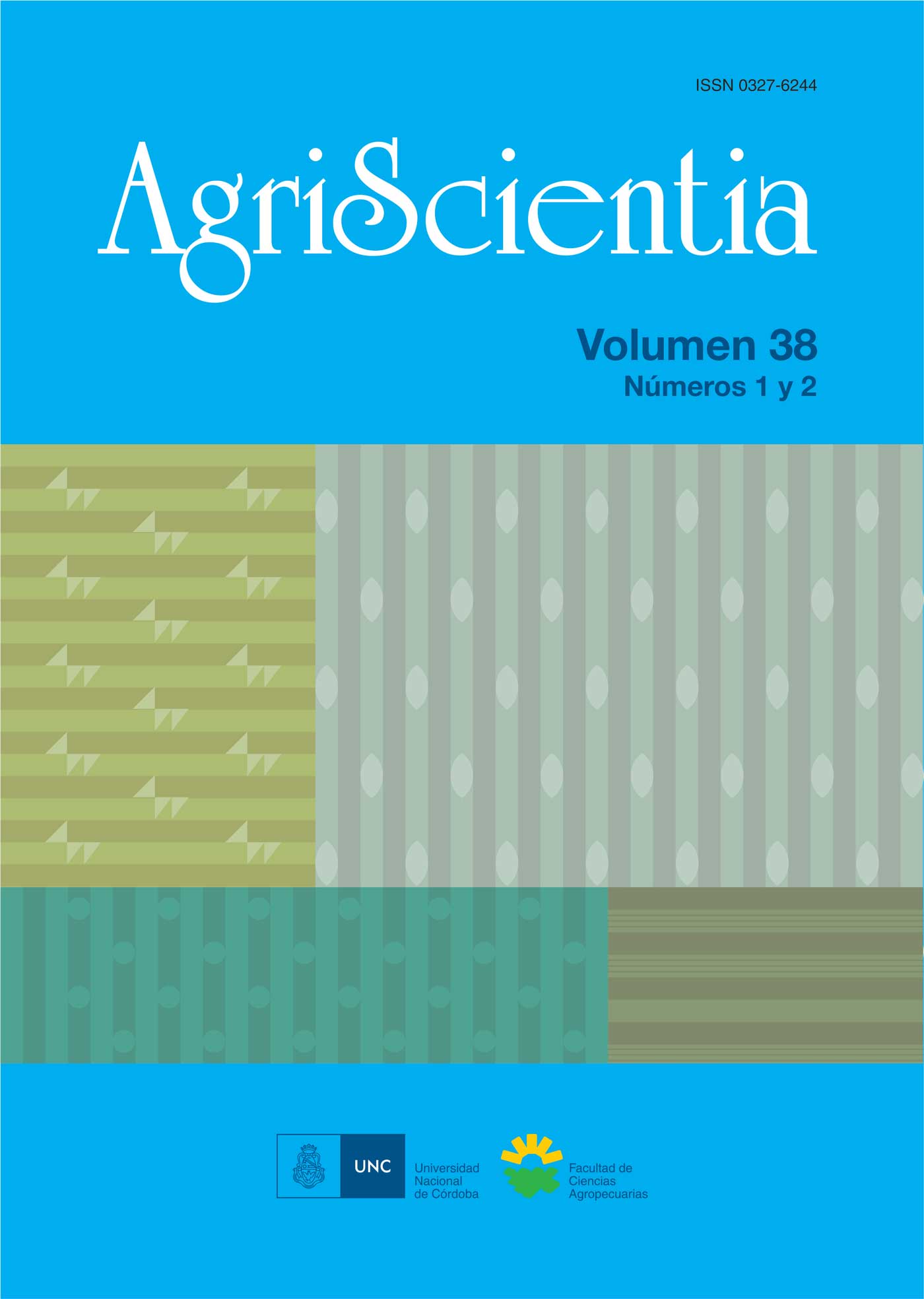Reaction of grapevine rootstocks and cultivars to Meloidogyne incognita, M. arenaria and M. hapla
Main Article Content
Abstract
This study aimed to evaluate the reaction of six grapevine rootstocks (MGT 101-14, Ritcher 110, Paulsen 1103, K 5BB, SO4, Salt creek) and two cultivars (Quebranta and Torontel) to three species of the root-knot nematode (Meloidogyne incognita, M. arenaria and M.hapla). The experiment was performed as a completely randomized design with an 8 × 3 factorial scheme and six replicates per treatment. The experimental unit in each replicate comprised a grapevine cutting planted in 3 kg bags with sterilized soil. Cuttings were inoculated with 5000 eggs + juveniles (J2) of M. incognita, M. arenaria and M. hapla. Six months after inoculation, plants were removed from the bags, and the reaction was determined by evaluating the number of galls (NG), number of nematodes per gram of root (NNGR), and reproduction factor (RF). The evaluated rootstocks, MGT 101-14, Ritcher 110, Paulsen 1103, K 5BB, SO4 and Salt Creek, were resistant to M. incognita, M. arenaria and M. hapla, except for Salt creek, which was susceptible to the latter. The Quebranta and Torontel cultivars were susceptible to the Meloidogyne species under study.
Downloads
Article Details

This work is licensed under a Creative Commons Attribution-ShareAlike 4.0 International License.
References
Aballay, E. and Vilches, O. (2015). Resistance assessment of grapevine rootstocks used in Chile to the root knot nematodes Meloidogyneethiopica, M. hapla, and M. javanica. Ciencia e Investigación Agraria, 42 (3), 407-413. DOI: https://dx.doi.org/10.4067/S0718-16202015000300009
Bavaresco, L. and Lovisolo, C. (2015). Effect of grafting on grapevine chlorosis and hydraulic conductivity. VITIS-Journal of Grapevine Research, 39 (3), 89. DOI: https://doi.org/10.5073/vitis.2000.39.89-92
Boubals, D. (1992). Ausujet de larésistance à l’anguillule de lavigne. Le Progrès Agricole et Viticole. 109 (2), 118.
Carneiro, R. and Almeida, M. (2001). Técnica de eletroforese usada no estudo de enzimas dos nematoides das galhas para identificação de espécies. Nematologia Brasileira, 25, 35-44.
Dalmasso, A. and Cuani, A. (1976). Resistancedes porte-greffes de vignes a differentes populationsdunematodo Meloidogyne hapla. ProgresAgricole et Viticole 93(25), 800-807.
Ferris, H., Zheng, L. and Walker, M. A. (2012). Resistance of grape rootstocks to plant-parasitic nematodes. Journal of Nematology, 44 (4), 377-386. Retrieved from: https://pubmed.ncbi.nlm.nih.gov/23482972/
Ferris, H., Zheng, L. and Walker, M. A. (2013). Soil temperature effects on the interaction of grape rootstocks and plant-parasitic nematodes. Journal of Nematology, 45, 49–57. Retrieved from: https://www.ncbi.nlm.nih.gov/pmc/articles/PMC3625132/pdf/49.pdf
Fort, K., Fraga, J., Grossi, D. and Walker, M. A. (2017). Early measures of drought tolerance in four grape rootstocks. Journal of the American Society for
Horticultural Science, 142, 36-46. DOI: https://doi.org/10.21273/JASHS03919-16
Gutiérrez-Gutiérrez, C., Palomares-Rius, J. E., Jiménez-Díaz, R. M. and Castillo, P. (2011). Host suitability of Vitis rootstocks to root-knot nematodes (Meloidogyne
spp.) and the dagger nematode Xiphinema index, and plant damage caused by infections. Plant Pathology, 60 (3), 575- 585. DOI: https://doi.org/10.1111/j.1365-
2010.02404.x
Hartmann, K. M. and Sasser, J. N. (1985). Identification of Meloidogyne species on the basis of differential hosts tests and perineal–patternmorphology. In: K. Barker,
C.C. Carter and J. Sasser (Eds.). In AnAdvancedTreatiseonMeloidogyne. Vol. II: Methodology (69–77). Raleigh, UnitedStates: Department of PlantPathology,
North Carolina StateUniversity.
Hussey, R. and Barker, K. R. (1973). A comparison of nematodes of collecting inocula for Meloidogyne spp, including a new technique. Plant DiseaseReport, 57, 1025–1028.
McKenry, M. V. and Anwar, S. A. (2006). Nematode and grape rootstock interactions including an improved understanding of tolerance. Journal of Nematology, 38 (3), 312-318. Retrieved from: https://www.ncbi.nlm.nih.gov/pmc/articles/PMC2586707/
Ministerio de Agricultura y Riego de Perú (MINAGRI) (2019). La uva peruana: Una oportunidad en el Mercado Mundial. Retrievedfrom: https://cdn.www.gob.pe/uploads/document/file/419832/Informe-Uvaperuana.pdf
Moura, M. F., Tecchio, M. A., Dias-Arieira, C. R., Puerari, H. H., Cunha, T. P. L. and Chiamolera, F. M. (2014). Reaction of grape rootstocks to Meloidogyne incognita and M. javanica. Acta horticulturae, 1046, 109-112. DOI: https://doi.org/10.17660/Acta
Hortic.2014.1046.12
Ollat, N., Bordenave, L., Tandonnet, J. P., Boursiquot, J. M. and Marguerit, E. (2016). Grapevine rootstocks: origins and perspectives. ActaHorticulturae,1136, 11–22. DOI: https://doi.org/10.17660/ActaHortic.2016.1136.2
Oostenbrick, M. (1966). Major characteristics of the relation between nematodes and plants. Mendelingen / Landbouhogeschool, Wageningen, 66, (1), 46.
Peccoux, A., Loveys, B., Zhu, J., Gambetta, G. A., Delrot, S., Vivin, P., Schultz, H. R., Ollat, N. and Dai, Z. (2018). Dissecting the rootstock control of scion transpiration using model-assisted analyses in grapevine. TreePhysiology, 38(7), 1026-1040. DOI: https://doi.org/10.1093/treephys/tpx153
Perry, R. and Moens, M. (Eds.) (2013). PlantNematology, Secondedition. Wallingford, Oxfordshire, UK: CABI Publishing.
Statistical Analysis System (SAS) (University Edition version) [Software].São Pablo, Brazil: SAS Institute. Retrieved from: https://www.sas.com/pt_br/software/
university-edition/download-software.html
Seccia, A., Santeramo, F. G. and Nardone, G. (2015). Trade competitiveness in table grapes: a global view. Outlook on Agriculture, 44 (2), 127-134. DOI: https://
doi.org/10.5367/oa.2015.0205
Sohrabi, S., Ebadi, A., Jalali, S. and Salami, S. A. (2017). Enhanced values of various physiological traits and VvNAC1 gene expression showing better salinity
stress tolerance in some grapevine cultivars as well as rootstocks. ScientiaHorticulturae, 225, 317–326. DOI: https://doi.org/10.1016/j.scienta.2017.06.025
Somavilla, L., Bauer Gomes, C. and Quecini, M. V. (2012). Registro da ocorrência de Meloidogyne incognita no Porta-Enxerto ‘Iac 766-Campinas’ no Estado De Pernambuco e reação de porta-enxertos e de cultivares copa de videira a Meloidogyne spp. Revista Brasileira de Fruticultura, 34 (3), 750-756. DOI: https://
dx.doi.org/10.1590/S0100-29452012000300014
Téliz, D., Landa, B. B., Rapoport, H. F., Pérez Camacho, F., Jiménez-Díaz, R. M. and Castillo, P. (2007). Plantparasitic nematodes infecting grapevine in Southern
Spain and susceptible reaction to root-knot nematodes of rootstocks reported as moderately resistant. PlantDisease, 91 (9), 1147-1154. DOI: https://doi.org/10.1094/PDIS-91-9-1147
Varas Huaroto, N. (2018). Caracterización de poblaciones peruanas del nematodo del nódulo de la raíz (Meloidogyne spp.) en vid (Vitis vinífera L.). Tesis de maestría no publicada, Universidad Nacional Agraria La Molina, Lima, Perú. Retrieved from: http://repositorio.lamolina.edu.pe/handle/UNALM/3550
Zhang, L., Marguerit, E., Rossdeutsch, L., Ollat, N. and Gambetta, G. (2016). The influence of grapevine rootstocks on scion growth and drought resistance.
Theoretical and Experimental Plant Physiology, 28 , 143–157. DOI: https://doi.org/10.1007/s40626-016-0070-x





